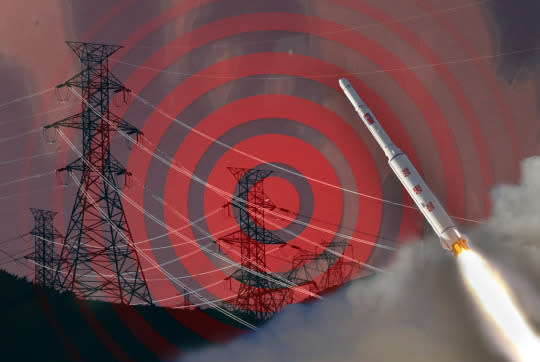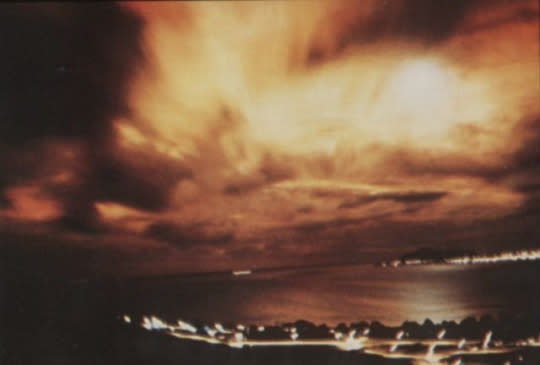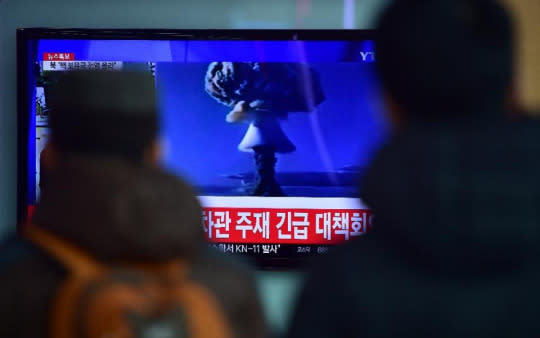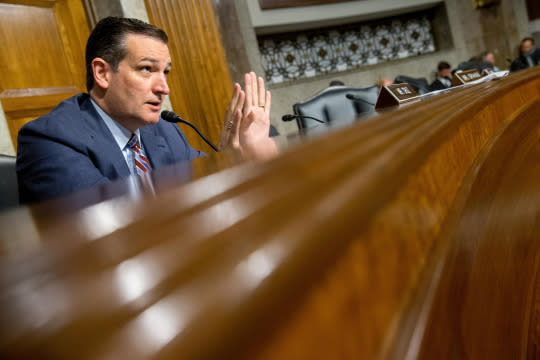GOP candidates keep warning of an EMP attack. Here’s what that is.

(Photo Illustration: Yahoo News, photos: Mike Dobel/Masterfile/Corbis, KCNA/Reuters, Korea Aerospace Research Institute/Reuters, AP)
What do the James Bond film “A View To A Kill,” the dystopian John Carpenter flick “Escape from L.A.,” and the grisly, made-for-TV movie “The Day After” have in common with the battle for the 2016 Republican presidential nomination? All have raised, to varying degrees, the possibility that an enemy of America could unleash a devastating electromagnetic pulse (EMP) attack that would fry U.S. electronics.
Last week, former Florida Gov. Jeb Bush became the latest GOP White House hopeful to express his concerns about what he called the “scary as crap” possibility of an EMP strike on the U.S.
In an interview with Politico, Bush described a back-and-forth on the subject with a woman at a town hall-style meeting in Concord, N.H.
“She said, ‘I’m worried about EMPs. Are you?’” he recalled in the interview. “I had just read an article about electromagnetic pulse and [how it could] take out the grid. It’s scary as crap. It’s one of the scariest things that could happen.”
It’s not often you hear a presidential candidate describe something as “scary as crap.” Not in public, anyway. But Bush is hardly the first 2016 hopeful to declare himself worried about EMPs — Texas Sen. Ted Cruz, former neurosurgeon Ben Carson, former senator Rick Santorum and former Arkansas Gov. Mike Huckabee have all weighed in.

Republican presidential candidate Jeb Bush speaks during a campaign event Friday, Feb. 5, 2016, in Concord, N.H. (Photo: Jim Cole/AP)
“An EMP is a devastating explosion that sends a pulse that knocks out all electric, everything — everything that is connected to any kind — that is wired, that has a circuit board, gets fried out. Everything is gone. Cars stop. Planes fall out of the sky,” Santorum said during a Fox Business Network debate in January. The former Pennsylvania senator had been asked whether he had a plan to protect America’s critical infrastructure from terrorist attacks.
“We have enemies who are obtaining nuclear weapons that they can explode in our exoatmosphere and destroy our electric grid,” Carson, who has raised the issue before, said at the same debate.
And Huckabee mentioned EMPs at his campaign launch in May 2015, citing “threats of an electromagnetic pulse from an exploded device that could fry the electrical grid and take the country back to the Stone Age in a matter of minutes.”
At a time when Americans are focused on the possibility of terrorist attacks by the so-called Islamic State, EMPs might seem like a weird threat to single out for attention. Scientists and national security experts consulted by Yahoo News agreed that the electrical grid needs security upgrades, and that using a nuclear weapon to carry out an EMP attack might have the potential to be devastating — but also said that scenario is far-fetched.
Warnings about EMPs have been kicking around since July 1962, when the U.S. carried out a nuclear test named Starfish Prime. The military detonated a 2,200-pound thermonuclear bomb 250 miles above the Johnston Atoll in the Pacific Ocean. The EMP that resulted from the 1.4-megaton blast knocked out some streetlights and telephones in Hawaii, some 900 miles away, and damaged a handful of satellites in orbit.

The Starfish Prime nuclear test explosion, seen through clouds, from Honolulu, Hawaii, on on July 9, 1962. (Photo: Nuclear Weapons Archive via Wikipedia)
While scientists knew that an atmospheric nuclear detonation would create an electromagnetic pulse, the range and effects of this test highlighted the phenomenon’s military potential. The U.S. and the Soviet Union began gaming out how best to use a high-altitude nuclear detonation to generate an EMP, and how to resist one. In the U.S., the military set about strengthening its facilities so they could survive electromagnetic pulses — one of Jeb Bush’s national security advisers, John Noonan, served in a nuclear-missile silo designed to resist them. The U.S. military also reportedly worked on a weapon that would operate like a non-nuclear EMP, but those efforts have apparently stalled, and no country is known to possess one, meaning an EMP attack would require an atomic detonation.
Heading into the first Gulf War, Gen. Norman Schwarzkopf asked President George Bush to green-light a nuclear EMP strike to knock out Iraqi electronics, according to Newsweek. Bush said no.
Hollywood brought the idea into the mainstream. Twenty-three years after the Starfish Prime test, “A View To A Kill” kicked off with 007 recovering an EMP-resistant microchip. In the unrelentingly bleak “The Day After,” from 1983, a Soviet nuclear strike unleashes an EMP that fries American communications and even cars. In 1996, “Escape from L.A.” anti-hero Snake Plissken sets off a non-nuclear EMP weapon that knocks out power around the entire world. Most recently, in the 2012 version of “Red Dawn,” an EMP cripples American defenses, paving the way for a North Korean invasion of the U.S. mainland.
The attacks of Sept. 11, 2001, gave the idea of an EMP attack new prominence in political circles, primarily among a relatively small band of conservatives. One of the first to sound the alarm was Republican former congressman Roscoe Bartlett. Bartlett, who today lives off the grid, played a leading role when Congress created its own Electromagnetic Pulse Commission 15 years ago. The panel released several reports, including one in April 2008 that warned of “catastrophic consequences” from EMP attack, and called for steps to protect vital national infrastructure.
In hearings throughout the decade, lawmakers again and again suggested that China, Iran, or terrorist groups could someday launch an EMP attack — to devastating effect.

Jason Robards as Dr. Russell Oakes in the 1983 ABC TV movie, “The Day After,” a disturbing film about the effects of a devastating nuclear holocaust on small-town residents in eastern Kansas. (Photo: ABC/Getty Images)
Bartlett worked harder than anyone to spread the word, repeating his warnings in countless congressional hearings. But perhaps no one ultimately played a bigger role in spreading information about the dangers of EMPs than former House Speaker Newt Gingrich. Not only did Gingrich tell Congress in 2005 that Iran might launch a nuclear-tipped missile at the U.S. “from the middle of the ocean,” he raised the issue again and again in speeches during his 2012 presidential campaign.
Today, the issue remains chiefly Republican, though the House of Representatives EMP Caucus founded in 2011 is a bipartisan 20-member affair. As is frequently the case when federal dollars might be involved, there is also an advocacy group, EMPact America, to pressure Congress to take action. And the conservative Heritage Foundation has repeatedly published warnings about the need to protect the electrical grid — not just from military EMP strikes but also from solar flares that could have a relatively similar impact.
“Communications would collapse, transportation would halt, and electrical power would simply be nonexistent,” according to a Heritage report from November 2010. “Not even a global humanitarian effort would be enough to keep hundreds of millions of Americans from death by starvation, exposure, or lack of medicine. Nor would the catastrophe stop at U.S. borders. Most of Canada would be devastated, too, as its infrastructure is integrated with the U.S. power grid. Without the American economic engine, the world economy would quickly collapse. Much of the world’s intellectual brain power (half of it is in the United States) would be lost as well. Earth would most likely recede into the ‘new’ Dark Ages.”
Bush told Politico that he was prepared to answer the woman’s question because he had read an article on EMPs a week earlier. It’s not clear what article Bush read; his aides wouldn’t say. And it wasn’t clear why he chose to get up to speed on EMPs at this point in the campaign.
But he had pretty good timing. Nuclear-armed North Korea recently fired a rocket that carried a satellite into orbit, prompting Cruz to raise the possibility that the Hermit Kingdom might attempt an EMP attack.

People watch a news report on North Korea’s latest nuclear test at a railway station in Seoul, Korea, on Jan. 6, 2016. (Photo: Jung Yeon-Je/AFP)
“One of the real risks of this launch [is] North Korea wants to launch a satellite, and one of the greatest risks of the satellite is they would place a nuclear device in the satellite,” Cruz said at a Republican debate that followed the launch. “As it would orbit around the Earth, and as it got over the United States they would detonate that nuclear weapon and set off what’s called an EMP, and electromagnetic pulse which could take down the entire electrical grid on the Eastern seaboard, potentially killing millions.”
It wasn’t the first time Cruz had delivered that warning. At a July 2015 Senate Armed Services Committee hearing, the Texas senator used the same argument to attack President Obama’s nuclear deal with Iran.
“The single greatest threat to the United States, if Iran acquires a nuclear weapon, is that of an electromagnetic pulse. A nuclear weapon detonated in the atmosphere over the Eastern seaboard that could kill tens of millions of Americans,” he told Energy Secretary Ernest Moniz in a testy back and forth.
“Do you agree that an EMP detonated by Iran in the atmosphere could kill tens of millions of Americans?” Cruz demanded.
SLIDESHOW – Republican candidates duke it out in South Carolina >>>
“An EMP detonated by anyone obviously is a very potent weapon,” Moniz replied. But the energy secretary with Beethoven-style hair added that the amount of potential damage “depends on the specifics” of the weapon.
It’s not clear precisely when Cruz took up the EMP cause. He raised the issue at a July 2014 Senate hearing as well. But his foreign policy adviser, Victoria Coates, told Yahoo News it predates his time in Washington.
“It is a big issue in Texas, so Senator Cruz was aware of it coming in, and directed staff to pay attention,” she said in a email to Yahoo News. Coates pointed to power outages caused by Hurricane Sandy as an example of the vulnerabilities of America’s electrical grid, and suggested that “reasonably priced, common sense steps” could mitigate the problem.
But how big a problem it is remains unclear, according to several experts consulted by Yahoo News. According to the Federation of American Scientists, it would take “a large device” exploded 250 to 300 miles over Kansas to affect the entire continental United States. The Atlantic reported in July 2011 that one study predicted an EMP might knock out as much as 70 percent of U.S. electronics or as little as five percent. Meanwhile, electromagnetic pulses did not rate even a passing mention when Director of National Intelligence James Clapper appeared before the Senate Armed Services Committee and Senate Intelligence Committee last week in wide-ranging hearings on threats to U.S. national security.

Senate Armed Services Committee member and Republican presidential candidate Sen. Ted Cruz, speaks on Capitol Hill in Washington on July 29, 2015, during the committee’s hearing on the impacts of the Joint Comprehensive Plan of Action on U.S. interests and the military balance in the Middle East. (Photo: Andrew Harnik/AP)
“The trouble is that the science is untested and the strategy is implausible,” one retired career national security official told Yahoo News. It’s not that the civilian electrical grid isn’t vulnerable. “Far from it,” said that official, who requested anonymity because they are not supposed to talk to the media. But there are less risky ways to cause chaos. A cyberattack has the potential to cause just as much damage and would be easier to disguise – potentially avoiding what would surely be massive retaliation by the U.S. military.
“EMP is real,” arms control expert Joe Cirincione told Yahoo News. “There are some scenarios in which an adversary starts a nuclear war with one solo launch at high altitude with a big multimegaton explosion to blind the enemy’s radars and C3 [command, control, communications]. But that is then followed by hundreds or thousands of warheads that hit their targets.”
While the Cold War-style scenario may be plausible, the rogue nation or terrorist threat is not, Cirincione said. First, a rogue nation would expose itself to an almost certain nuclear counterattack. Second, a terrorist group that somehow came into possession of a nuclear weapon would have better uses for it.
“Why would they waste it to cause some temporary damage to electronic systems when they could explode it in the middle of the city and cause permanent damage to a much greater extent?” he asked. “Do you want to blind New York or destroy New York?”

